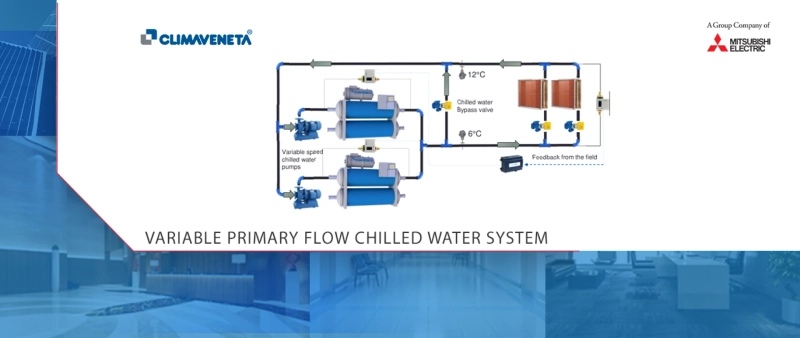The advancement in technology for HVAC controls applied to water cooled chiller systems makes it possible to reduce the environmental impact and operating costs.
Industrial chillers are the biggest power consuming equipment in the chiller system but other equipment such as pumps, cooling towers and or dry coolers, Cooling tower fans and other motors should also be considered
A variable flow distribution pumping system to serve the HVAC load is one of the methods to reduce the initial cost and operating cost — depending on the application and the spread area of chilled water load. (speed and pressure modulation is usually accomplished by providing the chilled water pump with a variable frequency drive)
In primary variable flow system, chiller water flow rate is varied in the water cooled chiller depending on the load. This enables to work on higher deltaT unlike lower delta T syndrome happening in traditional Primary + Variable secondary systems. The effect is reduction in the cost of procuring water and pumping load, translating into savings in initial cost and as well as the operating cost.
In primary variable flow systems, evaporator shall be suitable for variable flow operation. i.e. designed to perform proper heat transfer at different water velocities across the tubes.
Generally the flow will be varied between 40% to 100% of the design flow, depending on the load condition. Another important factor to be considered while designing primary variable flow system is that the chilled water flow change rate change should not be more than 2% from the previous flow within 10 Minutes of band. Very fast flow variation to the chiller can lead to operational problems and impact the efficiency of the system and the evaporator as well.
Water flow to the water cooled chiller is to be ensured within the chiller operating limits even during the low load operation. So, we need to employ sophisticated control arrangements for the primary variable flow operation.
The diagram below explains the configuration and working principle of a water cooled chiller’s primary variable system.
Chilled water flow is varied according to field demand.Flow through each water cooled chiller is monitored and compared against design through a flow meter. Chilled water pump speed modulates to maintain a set field DP across the water cooled chiller system i.e. between the supply and return header.As field demand decreases, field DP will increase. An increase in field DP above set-point will reduce water cooled chiller pump speed and thereby the flow.A decrease in field DP below set-point will increase water cooled chiller pump speed and thereby the chilled water flow.The chilled water bypass valve remains closed until any one of the operating chillers flow rate falls below 80% of design (is also user configurable)Chilled water bypass will also modulate to maintain a minimum safe flow through the chillers.If the bypass valve is opened 100% and flow rate across the evaporator is less than the minimum flow required, (in case of low loads) pump speed will be ramped up to maintain safe water flow through the water cooled chillers.
For more details visit us!
https://in.climaveneta.com/en?utm_source=Off-Page&utm_medium=Organic&utm_campaign=Article
0


